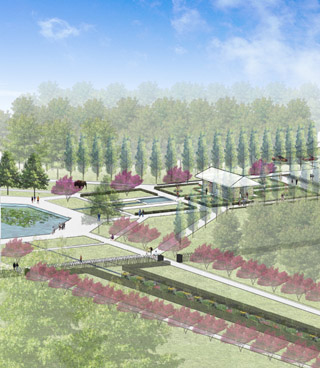
Surveys
DJC.COM
April 17, 2008
Seattle designer has a renaissance in North Dakota
Charles Anderson Landscape Architects

Anderson
|
It is a few days before Christmas and I am 35,000 feet in the air en route to North Dakota, not for the holidays but for a new project. My 50th year has brought me full circle, to a project in my home state.
The International Peace Garden project brings me home. Ironic, too, that it is about peace when so much of my career has been anything but peaceful.
My recollection of the garden from my childhood was a huge floral clock, which really worked, but not much else. I was an 8-year-old.
The International Peace Garden is a 2,339-acre property straddling the borders of North Dakota and Manitoba, Canada. Horticulturist Henry Moore conceived the idea for the garden in 1928. His vision was to create a park “where the people of two countries could share the glories found in a lovely garden and the pleasure found in warm friendships.”

Image courtesy of Charles Anderson Landscape Architects Initial improvements to International Peace Garden will include a restoration of the sunken garden. |
Moore was a Kew graduate and a big-idea thinker as a landscape designer. In the early 1900s, Moore had been the head gardener of the Niagara Parks Commission, responsible for laying out Queen Victoria Park in Niagara Falls, Ontario. Originally, they were considering Niagara Falls as the ideal place to build the peace garden but the river divided the two countries, making it unfeasible on a conceptual level.
Moore began a cross-country tour of the border between the two countries, from the East Coast to the West. As he approached the center of the continent, he saw the loveliest anomaly of trees and lakes in the hills surrounded by prairies and farmlands. This would become the site, located on the 49th parallel, midpoint between the Atlantic and the Pacific and only a 45-minute drive north of the geographic center of North America.
The size and scale of the garden rivaled other great gardens of the day. The plan matches the size of the Washington Mall and the great gardens of Versailles. The garden would allow visitors to cross between countries seamlessly while admiring the grand expanse of the property. The original boundary marker within the garden is a cairn built of stones from both countries with a plaque that reads: “To God and His Glory we two nations dedicate this garden and pledge ourselves that, as long as man shall live we will not take up arms against one another.”
North Dakota donated 888 acres of the park while the province of Manitoba provided the remaining 1,451.
The garden was dedicated with great fanfare in 1932 in front of 52,000 people. Imagine, North America was caught up in the bitter grip of the Great Depression and a generation had been lost during World War I.
In 1934, when funds were short and labor was not, the U.S. Civilian Conservation Corps was engaged under the supervision of the National Park Service to improve the garden. They fenced the United States acreage, cleared bush land, built lagoons and constructed the first building, the Historic Lodge, made of native stone from North Dakota and logs from the Duck Mountains of Manitoba. This left a beautiful handcrafted heritage to the garden.
Many other improvements were made to the garden over the decades leading to today, but drainage problems, decades of “deferred” maintenance and hundreds of grazing deer have worked against them.
Enter current garden director Doug Hevenor, a Niagara Parks graduate bringing with him a respect for the past along with the energy and vision to revitalize the gardens and a passion for all things green. With the design team intact — including Guy Prefontaine of GPP Architects in Winnipeg as project manager, Fresien Tokar of Winnipeg as architect of record, Earthtech of Winnipeg as civil and structural engineer, EAPC of Grand Forks as construction manager and us as landscape architect — we began work on the first of three phases.
Phase one includes a new visitor center, conservatory and restoration of the park’s largest garden, the sunken garden. The design for that project was recently completed. Phase two includes the construction of an International Center for Peace, while the third phase includes an Accommodations Center. Some of the phases are fully funded, but many of them are still seeking partners.
The International Peace Garden is entering a renaissance period that extends the original focus of peace between Canada and the United States to world peace. The location is one of the most rigorous climates in the United States. A more dramatic setting could not be sought than the pristine forest of aspen, oak and birch perched several hundred feet above the surrounding prairies. Once you visit, you can see why Moore chose this location for the peace garden.
That mid-December meeting was cold but my second visit in January shouldered wind chill temperatures exceeding 45 degrees below zero. Hoarfrost covered the trees and I could only manage 45 minutes outside. A couple of Moose objected to my visit and the landscape was in a sort of suspended animation, covered in snow, awaiting spring. Our drawings showed the colors that will once again cover the grounds and contrast with the browns, grays and white of deep winter.
I am proud and glad to be back, sharing my experiences with the people of my upbringing. Construction starts soon and I cannot wait to see the progress.
Charles Anderson is a principal of Charles Anderson Landscape Architecture. He has more than 20 years of experience in projects ranging from neighborhood parks to New York’s American Museum of Natural History.
Other Stories:
- Landscape design inspiration beyond the office walls
- Easy steps to successful wetland mitigations
- Are meadows the hot new landscape trend?
- Use a site analysis to value rural conservation lands
Copyright ©2009 Seattle Daily Journal and DJC.COM.
Comments? Questions? Contact us.